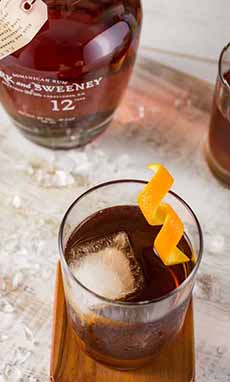PRODUCT CHOICE: La Pivon Spanish Vermouth
|
|
March 21st is National Vermouth Day. In the U.S., that largely means dry [white] vermouth, in a Martini. But don’t mix that Martini just yet. Or a Manhattan, the other prominent American cocktail that has red vermouth in the recipe. There are a number of different vermouth styles: sweet and dry, red and white, amaro (with added bitters), chinato with added chinchona (quinine) and often gentian (a root), alla vaniglia with vanilla, and others. Vermouth houses typically make a variety of styles. Today for brunch*, we had a sweet red vermouth from Spanish producer La Pivón, along with a delicious (and easy to prepare) tapas brunch. In fact, red vermouth is very popular among the fashionable people of Madrid. It’s enjoyed during “La Hora de Vermut,” (“vermouth hour”—read more about it here). That’s before lunch with tapas. Madrileños (residents of Madrid) typically consume it over ice with a splash of sparkling water and an orange slice garnish. Vermouth is a fortified wine that is flavored and aromatized with a proprietary blend of botanicals. The botanicals are a mix of barks, flowers, herbs, roots, seeds, and spices. The specific botanicals and the amounts used are proprietary to each producer. Red vermouth is made from red wine; white vermouth has a base of white wine. The botanicals are macerated in the wine for aroma and flavor; then, the wine is often fortified with distilled alcohol (La Pivón has no distilled alcohol). Check out the history of vermouth. La Pivón is a vermouth crafted in Madrid in the traditional Spanish style. In Spanish, the “h” is dropped: It’s vermout. Also in Spanish, La Pivón is slang for a very attractive person. When you give a bottle as a gift, make this fact known. La Pivón is the only vermouth producer in Madrid. It makes a sweet rojo (red) and a dry blanco (white). Because it has no added distilled alcohol, it’s a refreshing drink with a low A.B.V. (alcohol by volume; double it for the proof). The only alcohol is from the wine. Wonderfully aromatic, the herbal flavors are joined by spicy notes: cardamom, cinnamon, and clove. You may also find vanilla on the finish, from the French oak barrels. If refrigerated properly, the vermouth should keep anywhere from four to six weeks after opening. *TRIVIA: In English, “brunch” is a portmanteau of breakfast and lunch. In Spain, however, there’s no portmanteau. What we’d call brunch, they call el desayuno almuerzo, breakfast-lunch. |
|
|
|
||






